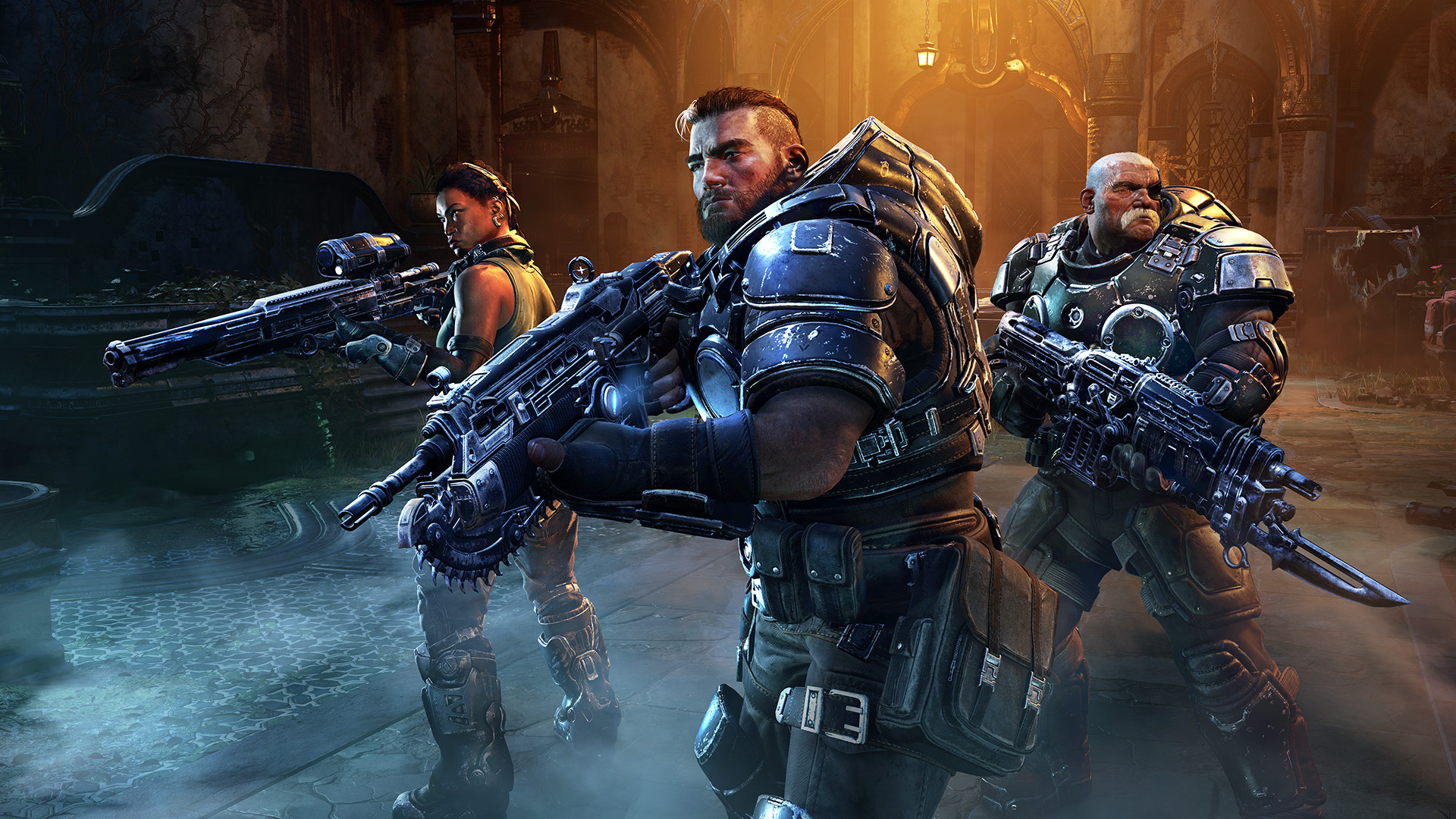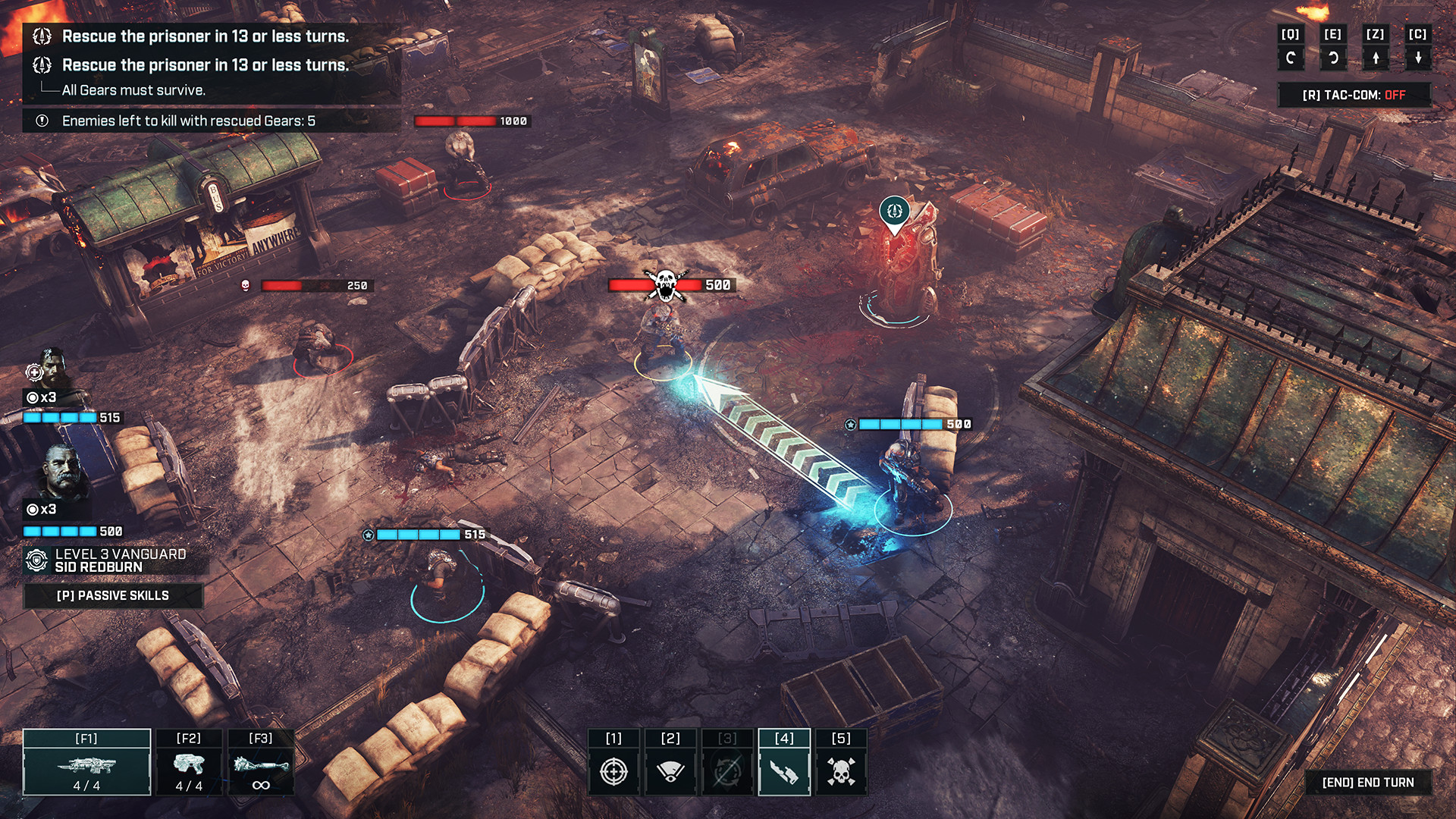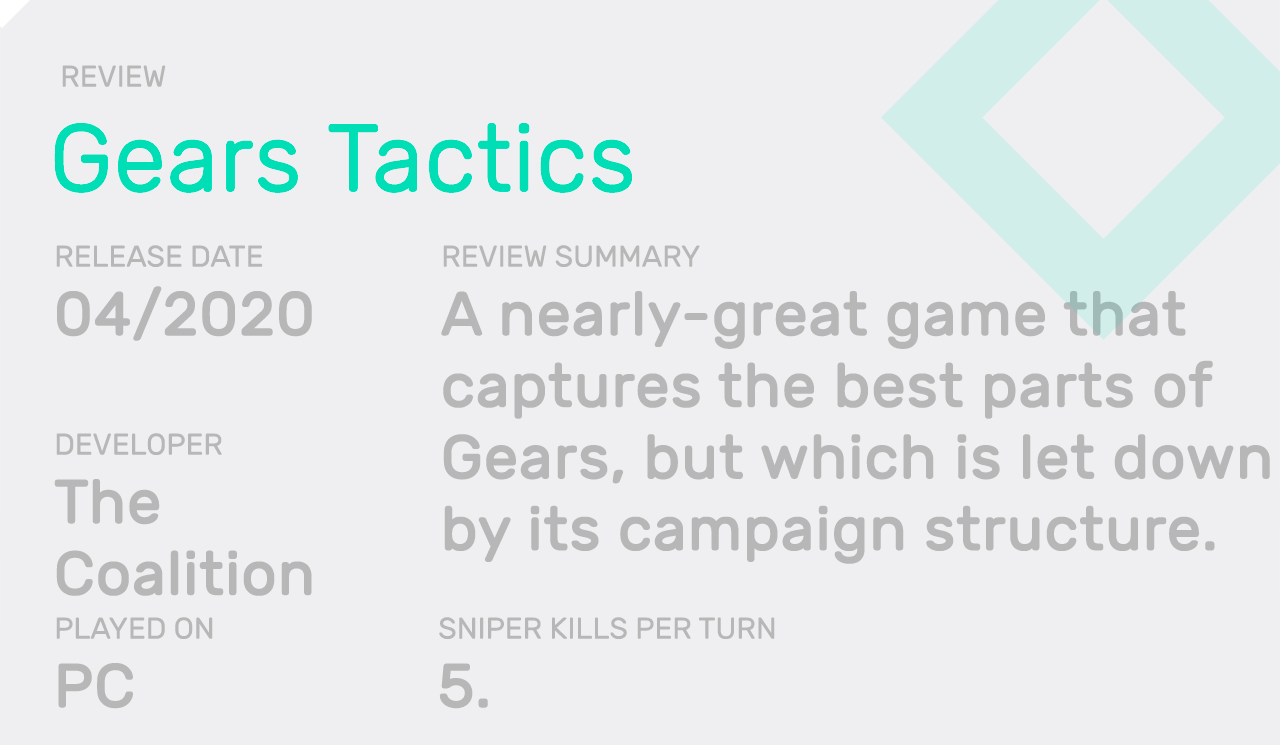Gears Tactics has a story to tell. It’s a good, classically Gears story about a disgraced hero recalled from the shadows to undertake a dangerous mission. It’s got a fractious, cobbled-together commando team learning to work together, dark political machinations lurking underfoot, and a fraught journey into the past for the key to the present. Your army will grow over time as new soldiers join your ranks, but the game revolves around the heroes of the story, whose deaths are failure conditions in every mission.
Most of the time, Gears Tactics manages this synthesis of action game narrative and tactical combat very well. Battles are dramatic and kinetic, with hordes of Locust troops frequently threatening to swamp your beleaguered fireteam unless you come up with a good plan, and quick. Each character can be developed along several different lines, and it can be a joy to see the way they fit together like the exact pieces you need to solve these puzzles at the most desperate moments of a mission. But its commitment to a single, linear narrative and the odd ways it employs the trappings of a modern action game can also make Gears Tactics feel confined. The good may far outweigh the bad, but it’s frustrating how often the bad feels like it is standing between Gears Tactics and a place among the genre’s greats.
Gears Tactics takes place years before Marcus Fenix was hauled out of his jail cell at the opening of Gears of War. The first image of the campaign is the footage of “Emergence Day” that opens the original game’s campaign, presented here not as backstory but as a recent world event. The invasion of the subterranean Locust is an apocalypse-in-motion, but ex-COG staff officer Gabe Diaz is through doing the dirty work of the corrupt Coalition of Ordered Governments, and has become the Achilles of the motor pool. His work stoppage is brought to an end by the arrival of the impossibly grizzled Sid Redburn, a cold, one-eyed killer who talks like John Wayne and comes bearing a secret mission to kill a particular Locust officer named Ukkon. COG is convinced Ukkon is the Dr. Moreau behind the Locust menagerie of weaponized monsters. Along the way, they meet up with a band of ad hoc civilian militia led by ace sniper, Mikayla Dorn, who has been fighting the Locust alone to protect her community, but despises the fascist COG.

Gears Tactics completely revolves around these three characters, maybe too much so. There is a subplot around the distrust between Mikayla’s people and their new Gears allies, but since the only characters given voice and action in the plot are Sid, Mikayla, and Gabe, its allusions to broader conflicts begin to feel like windows on the set of a stage play. Characters might go and gaze out of them at a painted backdrop and comment on what they see, but the audiences know perfectly well there is nothing there. That's how it feels when the plot hinges on dynamics within the team's camp, or their convoy's journey across the wasteland.
The bigger problem is that Gears Tactics is a game where you can only bring four characters on a mission, and with three main characters, you end up being encouraged or even forced to run similar squad setups again and again. That also means that the game concentrates experience on those hero characters, and there is almost no chance for non-hero recruits to keep pace with them. Gears Tactics’ solution to this problem is twofold. Between major story missions, you are often given a slate of “side missions” to choose from that impose different constraints about squad composition, banning a particular hero or limiting deployment slots or encouraging you to deploy a character from an under-used class. You have to run a handful of side missions between each story missions, and since they’re all happening “simultaneously,” you can’t use the same characters on different side-missions. This solution is somewhat effective at providing some extra variety, but it runs into trouble as there are so few side missions archetypes that they quickly become too similar to each other. The first time you have to outrun an advancing line of Locust carpet-bombing, it’s thrilling. The fifth time you do it, it’s utterly routine.
The other solution Gears Tactics employs is to give you regular slates of new recruits who come with enough XP to match your heroes… meaning that there is no real point to developing any of those early-game soldiers. Since the roster has limited spots, I quickly found myself dismissing soldiers I acquired early to free up space for the new, level-appropriate recruits. This wouldn’t be such a problem given that Gears Tactics clearly isn’t the kind of game where you invest in building up a personalized army, except that it includes tons of customization options as well as a very clunky equipment inventory that lets you put special armor on your soldiers that provides special buffs and bonuses. I got a matching set of armor that reduced the cooldown on hand grenades and increased their explosive radius, for instance, so I tossed them on a character who had some abilities that let them reduce their own ability cooldown timers, and suddenly I had a rapid-fire, human grenade-launcher. But Gears Tactics gives you such a deluge of items (collected via crates you find during the missions and “unlock” between them) and characters are so disposable that this kind of customization isn’t something I wanted to keep experimenting with, so once I had a build and itemization that I liked, I didn’t want to misplace it. If I replaced a character whose build I liked, I would almost certainly deploy my new recruit’s ability points along the exact same lines, and give them the exact same equipment.

It’s a shame Gears Tactics creates so many disincentives to experiment, because it has a deep ability system that creates a lot of variety on the battlefield. Each class archetype, from basic lancer-equipped “support” to the chaingun-wielding heavy, has an ability tree with four subclass quadrants that create very different possibilities. You can have a healer support who isn’t very aggressive in a fight but who can repair damage to both individual troopers and across the entire squad… or you can have a support who is effectively an assist-machine, giving bonus actions to other team members or gaining actions with every kill they amass. Or you can build some mix of these extremes, resulting in yet more ways the character could work as part of the squad.
On the other hand, there are places that Gears Tactics feels unbalanced in extremely familiar ways. Just like in the first XCOM, it doesn’t take long before the sniper class is completely out-of-control in terms of efficiency. By the middle of the game, my version of Mikayla could take her starting pool of three actions and, via her abilities, roll them into a total of nine actions. If she was well-situated, that translated to seven or eight shots with with a minimum 25% critical chance each time. By the time her she ran out of actions, the rest of the squad would often be left with nothing but mop-up. Meanwhile, the shotgun-wielding scout class was a consistent weak link no matter how I built them: they were never mobile enough to safely get within the comically short range of their blunderbuss of a shotgun. They weren’t viable at all early in the game and while some fun possibilities opened up later, there was nothing they offered that the rapid-rire snipers or the hard-charging vanguards couldn’t do better and from greater safety.
These problems might be the kiss of death for a more open-ended tactics game, but what helps save Gears is that, well, it’s about Gears and not XCOM. By design, it plays out like you are moving shooter characters around a battlefield. These characters are the heroes of a story, and your job is to set them up so that their innate, heroic badassery can carry the day yet again. When I found myself holed-up in an abandoned research center plant while a massive wave of Locust came pouring across a courtyard, I loved how quickly I was able to rip the heart out of that attack using the combination of a machine gunner in a flanking overwatch, a sniper on some high ground, and Gabe, who was going around administering coups de grace to generate extra actions for the squad as they downed their targets. It was like being put in charge of a really good Gears co-op round.

The game’s default difficulty might be so encouraging of these kinds of snowballing killstreaks that it starts to become a bit trivial, but the spike when I went to a harder difficulty was so severe it felt like a completely different game. I think Gears Tactics will be worth replaying on harder difficulty levels, but I also didn’t feel like the default game had prepared me at all for them. Enemy damage is so much higher, and light cover is so much less effective, that I effectively had to re-learn how to analyze the battlefield, because nothing I’d done before worked anymore. It’s a more interesting tactics game on harder difficulty levels, to be sure, but it’s not one that helps teach itself to you very well, in spite of an excellent tactical interface.
I’m still not sold on the boss battles but Gears Tactics uses them very sparingly. A bit like War of the Chosen, they’re uneven both in their difficulty and their entertainment value. One might require a virtuoso juggling act of incoming enemies and special boss attacks, while another is effectively hit points piñata whose attacks are so easily dodged that they pose more risk to other Locust than to you. But where War of the Chosen has you fight its major boss-type enemies multiple times before you finally dispense with them, Gears Tactics will throw you into a quick boss-level and then let you get back to the main, squad-centered battles.
When I look at Gears Tactics I see a game of parts that don’t quite fit together. It tells its story well, but in a way that can’t help but feel a little sparse, and its need to ensure that each mission hews closely to its narrative puts some handcuffs on a terrific tactics game. That tactical layer has a unique and convincing Gears-vibe that captures some of the best parts of this setting and series, but it is let down by a half-baked campaign structure. Sometimes those elements all find a moment of balance and you can appreciate the game’s possibilities and steadily darkening atmosphere. At those times, I couldn’t help but think how great Gears Tactics would be, if its campaign offered just a little more freedom, and allowed a little space for other characters to emerge as heroes in the course of play, not of plot.
from VICE https://ift.tt/2yLwAAN
via cheap web hosting
No comments:
Post a Comment